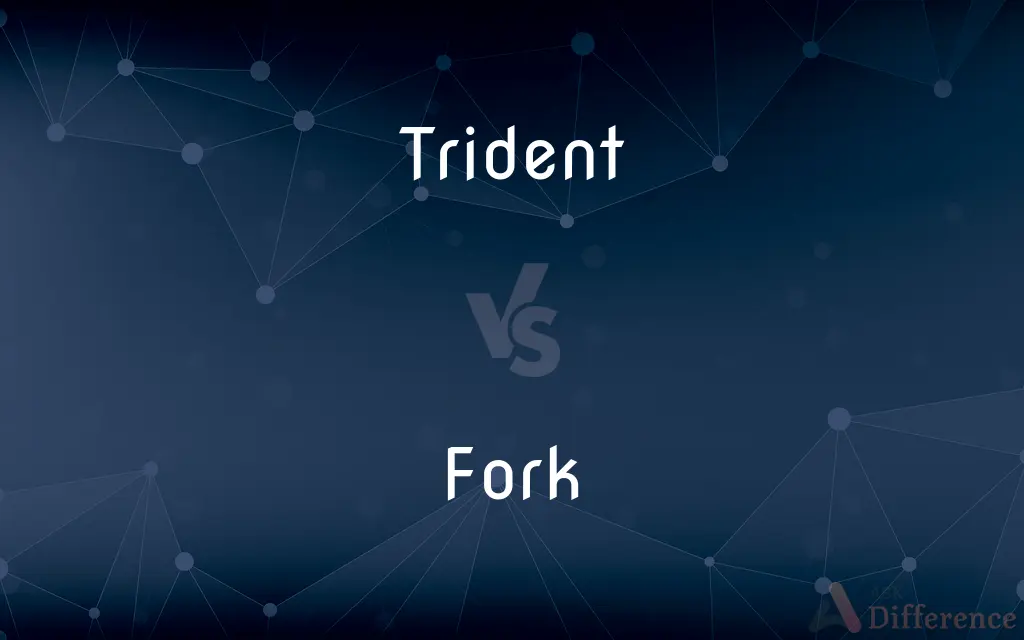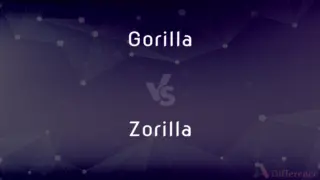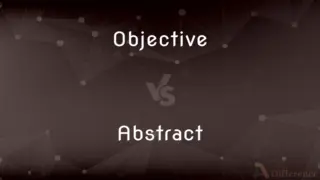Trident vs. Fork — What's the Difference?
By Tayyaba Rehman & Maham Liaqat — Updated on March 8, 2024
A trident is a three-pronged spear, primarily symbolic and used in mythology, while a fork is a common utensil with multiple tines for eating or serving food.

Difference Between Trident and Fork
Table of Contents
ADVERTISEMENT
Key Differences
Tridents are ancient weapons and symbols, often associated with deities like Poseidon or Neptune, representing power over the seas. They have a long shaft and typically three sharp points, designed more for combat or ceremonial purposes. On the other hand, forks are everyday tools found in kitchens and dining tables worldwide, consisting of a handle and several tines (usually four) used for picking up, holding, or cutting food.
Tridents have a strong cultural and mythological significance, embodying authority, control, and maritime dominion in various ancient civilizations. They're depicted in art and literature as the weapon of choice for sea gods, signifying their command over aquatic realms. Conversely, forks are utilitarian objects with a practical design, focused on functionality and convenience in eating habits, with no inherent symbolic meaning.
In terms of design, tridents are larger and more robust, intended for use as a weapon or a ceremonial item. Their long shaft and pointed prongs are designed for thrusting or fishing, indicating their martial or functional origin. Forks, however, are smaller, designed for manual use, with their tines shaped and spaced to efficiently pick up and hold food, reflecting their role in daily life and culinary practices.
While tridents are predominantly made of metal or wood and crafted for durability and strength, suitable for combat or ceremonial display, forks are made from a variety of materials including metal, plastic, or wood, depending on their intended use, whether for dining, cooking, or serving.
Tridents and forks serve different purposes in society; tridents are often seen in religious ceremonies, cultural festivities, or as historical weapons, symbolizing power and authority. Forks, in contrast, are integral to culinary culture, essential for a wide range of eating and cooking activities, highlighting the contrast between symbolic significance and practical utility.
ADVERTISEMENT
Comparison Chart
Purpose
Weaponry, ceremonial
Eating, serving food
Prongs
Three
Usually four, but varies
Symbolism
Power, control, maritime domain
None
Material
Metal, wood
Metal, plastic, wood
Cultural Significance
High, in mythology and religion
Low, everyday utility
Compare with Definitions
Trident
A three-pronged spear used as a weapon or a fishing tool.
The ancient warrior wielded a trident as his weapon of choice.
Fork
A utensil with multiple tines for eating or serving food.
She used a fork to twirl her spaghetti neatly.
Trident
A decorative element in art and architecture, inspired by its mythological significance.
The fountain's centerpiece was a large trident, paying homage to sea legends.
Fork
A tool in cooking and food preparation.
The chef used a large fork to turn the meat on the grill.
Trident
A symbol of authority, especially in maritime contexts.
The statue of Poseidon featured him holding a trident, asserting his dominion over the sea.
Fork
An essential item in table settings and etiquette.
Proper table manners dictate the correct placement of the fork to the left of the plate.
Trident
An implement in religious ceremonies or rituals.
The priest carried a trident during the waterfront blessing ceremony.
Fork
An implement in gardening or farming, similar in design to the eating utensil.
Using a gardening fork, he loosened the soil around the plants.
Trident
A tool in competitive sport fishing, resembling the ancient weapon.
He chose a modern trident for the spearfishing competition.
Fork
A decorative motif in various art forms, symbolizing food and dining.
The painting of the banquet table featured a prominently placed fork, adding to the realism.
Trident
A trident is a three-pronged spear. It is used for spear fishing and historically as a polearm.
Fork
In cutlery or kitchenware, a fork (from Latin: furca 'pitchfork') is a utensil, now usually made of metal, whose long handle terminates in a head that branches into several narrow and often slightly curved tines with which one can spear foods either to hold them to cut with a knife or to lift them to the mouth.
Trident
A three-pronged spear, especially as an attribute of Poseidon (Neptune) or Britannia.
Fork
A utensil with two or more prongs, used for eating or serving food.
Trident
A US design of submarine-launched long-range ballistic missile.
Fork
An implement with two or more prongs used for raising, carrying, piercing, or digging.
Trident
A long, three-pronged fork or weapon, especially a three-pronged spear used for fishing.
Fork
A bifurcation or separation into two or more branches or parts.
Trident
Greek & Roman Mythology The three-pronged spear carried by Neptune or Poseidon.
Fork
The point at which such a bifurcation or separation occurs
A fork in a road.
Trident
Having three teeth, prongs, or similar protrusions.
Fork
One of the branches of such a bifurcation or separation
The right fork.
Trident
A three-pronged spear somewhat resembling a pitchfork.
Poseidon's trident
Fork
(Games) An attack by one chess piece on two pieces at the same time.
Trident
(geometry) A curve of third order of the form:
Fork
To raise, carry, pitch, or pierce with a fork.
Trident
A kind of scepter or spear with three prongs, - the common attribute of Neptune.
Fork
To give the shape of a fork to (one's fingers, for example).
Trident
A three-pronged spear or goad, used for urging horses; also, the weapon used by one class of gladiators.
Fork
(Games) To launch an attack on (two chess pieces).
Trident
A three-pronged fish spear.
Fork
(Informal) To pay. Used with over, out, or up
Forked over $80 for front-row seats.
Forked up the money owed.
Trident
A curve of third order, having three infinite branches in one direction and a fourth infinite branch in the opposite direction.
Fork
To divide into two or more branches
The river forks here.
Trident
Having three teeth or prongs; tridentate.
Fork
To use a fork, as in working.
Trident
A spear with three prongs
Fork
To turn at or travel along a fork.
Fork
Any of several types of pronged (tined) tools (physical tools), as follows:
Fork
A utensil with spikes used to put solid food into the mouth, or to hold food down while cutting.
Fork
Any of several types of pronged tools for use on farms, in fields, or in the garden or lawn, such as a smaller hand fork for weeding or a larger one for turning over the soil.
Fork
A tuning fork.
Fork
(by abstraction, from the tool shape) A fork in the road, as follows:
Fork
(physical) An intersection in a road or path where one road is split into two.
Fork
(figurative) A fork.
Fork
(by abstraction, from the tool shape) A point where a waterway, such as a river or other stream, splits and flows into two (or more) different directions.
Fork
One of the parts into which anything is furcated or divided; a prong; a branch of a stream, a road, etc.; a barbed point, as of an arrow.
A thunderbolt with three forks
This fork of the river dries up during droughts
Fork
A point in time where one has to make a decision between two life paths.
Fork
(metonymically) Either of the (figurative) paths thus taken.
Fork
Process (software development, content management, data management) A departure from having a single source of truth (SSOT), sometimes intentionally but usually unintentionally.
Fork
(metonymically) Any of the pieces/versions (of software, content, or data sets) thus created.
Single source of truth, SSOT
Fork
(software) The launch of one or more separate software development efforts based upon a modified copy of an existing project, especially in free and open-source software.
Fork
The splitting of the coverage of a topic (within a corpus of content) into two or more pieces.
A content fork may be intentional (as from a schism about goals) or unintentional (merely from a lack of reorganizing, so far).
Fork
(cryptocurrency) A split in a blockchain resulting from protocol disagreements, or a branch of the blockchain resulting from such a split.
Fork
(chess) The simultaneous attack of two adversary pieces with one single attacking piece (especially a knight).
Fork
The crotch. en
Fork
(colloquial) A forklift.
Are you qualified to drive a fork?
Fork
Either of the blades of a forklift (or, in plural, the set of blades), on which the goods to be raised are loaded.
Get those forks tilted back more or you're gonna lose that pallet!
Fork
In a bicycle or motorcycle, the portion of the frameset holding the front wheel, allowing the rider to steer and balance, also called front fork.
The fork can be equipped with a suspension on mountain bikes.
Fork
Horse tack The upper front brow of a saddle bow, connected in the tree by the two saddle bars to the cantle on the other end.
Fork
(obsolete) A gallows.
Fork
(mining) The bottom of a sump into which the water of a mine drains.
Fork
(ambitransitive) To divide into two or more branches or copies.
A road, a tree, or a stream forks.
Fork
To spawn a new child process by duplicating the existing process.
Fork
To launch a separate software development effort based upon a modified copy of an existing software project, especially in free and open-source software.
Fork
To create a copy of a distributed version control repository.
Fork
(transitive) To move with a fork (as hay or food).
Fork
To kick someone in the crotch.
Fork
(intransitive) To shoot into blades, as corn does.
Fork
(transitive) fuck
Fork
To bale a shaft dry.
Fork
An instrument consisting of a handle with a shank terminating in two or more prongs or tines, which are usually of metal, parallel and slightly curved; - used for piercing, holding, taking up, or pitching anything.
Fork
Anything furcate or like a fork in shape, or furcate at the extremity; as, a tuning fork.
Fork
One of the parts into which anything is furcated or divided; a prong; a branch of a stream, a road, etc.; a barbed point, as of an arrow.
Let it fall . . . though the fork invadeThe region of my heart.
A thunderbolt with three forks.
Fork
The place where a division or a union occurs; the angle or opening between two branches or limbs; as, the fork of a river, a tree, or a road.
Fork
The gibbet.
Fork
To shoot into blades, as corn.
The corn beginneth to fork.
Fork
To divide into two or more branches; as, a road, a tree, or a stream forks.
Fork
To raise, or pitch with a fork, as hay; to dig or turn over with a fork, as the soil.
Forking the sheaves on the high-laden cart.
Fork
Cutlery used for serving and eating food
Fork
The act of branching out or dividing into branches
Fork
A part of a forked or branching shape;
He broke off one of the branches
They took the south fork
Fork
An agricultural tool used for lifting or digging; has a handle and metal prongs
Fork
The angle formed by the inner sides of the legs where they join the human trunk
Fork
Lift with a pitchfork;
Pitchfork hay
Fork
Place under attack with one's own pieces, of two enemy pieces
Fork
Divide into two or more branches so as to form a fork;
The road forks
Fork
Shape like a fork;
She forked her fingers
Common Curiosities
Is there a symbolic meaning behind tridents?
Yes, tridents are often associated with power, authority, and control over the sea, especially in mythology and religion.
What is a trident used for?
Historically, a trident was used as a weapon or a fishing tool, but it is often seen today as a ceremonial or symbolic item.
Can a trident be used as a fork?
While a trident could theoretically be used to pick up food due to its pronged design, its size and shape make it impractical for this purpose compared to a conventional fork.
Are all forks made of metal?
No, forks can be made from various materials, including metal, plastic, and wood, depending on their intended use.
Do forks have any cultural or symbolic significance?
Forks generally do not carry the same level of cultural or symbolic significance as tridents, being more focused on practical utility in dining and cooking.
Are tridents still used today?
While no longer used as weapons, tridents are still used in ceremonial, decorative, and symbolic contexts in various cultures.
What is the historical significance of tridents?
Tridents hold historical significance as ancient weapons and as symbols in various cultures, representing authority and maritime power.
What role do tridents play in modern culture?
Tridents appear in modern culture mainly through literature, film, and art, often drawing on their mythological and symbolic heritage.
What are the main differences between a trident and a fork?
The main differences lie in their purpose, design, and cultural significance; tridents are weapons or symbols, larger with three prongs, while forks are utensils for eating or serving, smaller with usually four tines.
How did tridents become associated with sea gods?
Tridents became associated with sea gods like Poseidon and Neptune due to their origins as fishing tools and weapons, symbolizing dominion over aquatic realms in mythology.
How has the design of the fork evolved over time?
Forks have evolved in design to accommodate various culinary needs, with changes in the number of tines and materials to suit different types of food and dining customs.
How are forks integrated into modern culinary practices?
Forks are integral to modern culinary practices, essential for a wide range of eating, cooking, and serving activities, reflecting their versatility and utility.
Can the design of a fork affect its functionality?
Yes, the design, such as the number and spacing of tines, can affect a fork's functionality in picking up and holding food.
What are the considerations in choosing a fork for dining?
Considerations include the type of food being eaten, the material of the fork, and cultural dining practices.
How do tridents and forks compare in terms of construction materials?
Tridents are typically made of more durable materials like metal or wood for strength and longevity, while forks can be made from a wider range of materials, including disposable options like plastic.
Share Your Discovery

Previous Comparison
Gorilla vs. Zorilla
Next Comparison
Objective vs. AbstractAuthor Spotlight
Written by
Tayyaba RehmanTayyaba Rehman is a distinguished writer, currently serving as a primary contributor to askdifference.com. As a researcher in semantics and etymology, Tayyaba's passion for the complexity of languages and their distinctions has found a perfect home on the platform. Tayyaba delves into the intricacies of language, distinguishing between commonly confused words and phrases, thereby providing clarity for readers worldwide.
Co-written by
Maham Liaqat














































